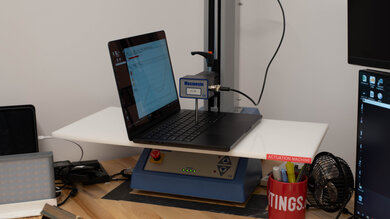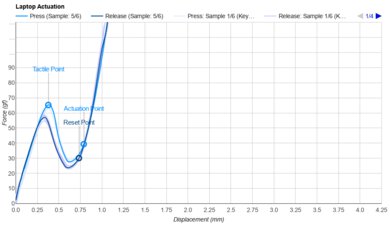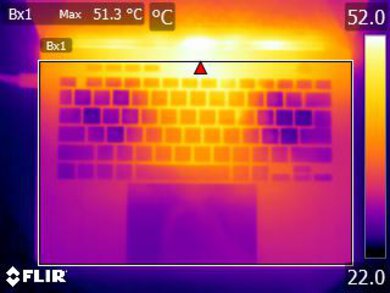
Laptops that are 13- and 14-inches are very similar and among the most popular sizes on the market. Most 13-inch models are actually 13.3- to 13.6-inch, so they're only slightly smaller than 14-inch models. Plus, as bezels continue to shrink, manufacturers can produce 14-inch laptops that are more compact than 13-inch models just a few years ago. These laptops are usually thin and lightweight, making them easy to carry around, but they aren't so small that they feel overly cramped. The biggest difference between the two sizes is that the 13-inch category consists mainly of ultraportables, i.e., thin and light laptops designed for general productivity, while the 14-inch category expands to more powerful devices like mobile workstations and gaming laptops. This is because more powerful processors need better cooling and, consequently, a larger chassis. As the 13- to 14-inch laptop market is large, choosing the right laptop for your needs and budget can be daunting, so we've compiled a list of our top picks to help narrow your options.
We've tested over 150 laptops, and below, you'll find our recommendations for the best 13- to 14-inch laptops. You can also check out our picks for the best laptops, the best Chromebooks, and the best business laptops. If you want to learn more about how we test laptops or our review process, check out this article, where we give you a quick rundown of each step from the moment we purchase the laptop to the final published review.
-
Best 14-Inch Laptop
School8.8Gaming7.6Multimedia8.5Workstation9.1Business8.5Build Quality9.5Brightness8.9Typing Quality8.0Touchpad9.2Webcam & Microphone9.1Ports8.5Battery Life (Web Browsing)15.7 hrsThe best 14-inch laptop we've tested is the Apple MacBook Pro 14 (2024), a premium 14-inch model. Designed for general productivity and various demanding workloads like content creation, 3D graphics, and simulations, it has tons of processing power to tackle nearly anything you throw at it. The overall user experience is amazing, as it sports a sturdy all-aluminum chassis, a sharp 120Hz Mini LED display, an easy-to-use haptic touchpad, and among the best speakers on the market. You also get a wide port selection for peripherals and external displays, comprising three USB-Cs, an HDMI 2.1, and a full-size SD card reader.
Aside from the expected performance increase over its M3 predecessor, the Apple MacBook Pro 14 (M3, 2023), this 2024 model brings a few noteworthy upgrades and new features. These include a higher peak display brightness of 1000 cd/m² in SDR (when outdoors or in very well-lit settings), a new nano-texture display that can further cut glare, and a 12 MP camera with Center Stage support, a feature that keeps you centered in the camera frame when you move around. Finally, the USB-C ports on the Pro and Max models now support Thunderbolt 5, tripling Thunderbolt 4 speeds, and the base M4 model gains an additional USB-C port with the same external display support as the Pro models.
-
Best Upper Mid-Range 13-Inch Laptop
School8.6Gaming6.1Multimedia8.0Workstation8.2Business8.1Build Quality9.5Brightness8.4Typing Quality8.0Touchpad9.2Webcam & Microphone8.7Ports5.0Battery Life (Web Browsing)12.3 hrsIf your workload doesn't need a lot of processing power, you'd probably be better off getting the Apple MacBook Air 13 (M4, 2025) instead. Not only is it lighter and more compact, but it's also more affordable, so you aren't paying for performance you don't need. It feels just as premium and sturdy as its Pro big brother, and it has the same tactile keyboard, haptic touchpad, and 1080p webcam with Center Stage support. Plus, this is a fanless device, which is great for noise-sensitive settings like classrooms and libraries.
Performance aside, there are a few downgrades from the MacBook Pro, like its port selection and display. In the former's case, you only get two USB-C/Thunderbolt 4s and a MagSafe charging port, so a dongle or dock might be necessary if you want to connect multiple peripherals. As for the display, although its Retina screen is sharp and colorful, it doesn't get nearly as bright as the MacBook Pro's Mini LED, especially in HDR. It also has a lower contrast ratio and a 60Hz refresh rate, making blacks appear gray in dim settings and reducing input responsiveness.
-
Best Mid-Range 14-Inch Laptop
School8.2Gaming6.6Multimedia7.8Workstation8.4Business8.2Build Quality8.0Brightness7.8Typing Quality7.5Touchpad7.6Webcam & Microphone7.8Ports9.0Battery Life (Web Browsing)11.4 hrsThe best 14-inch laptop we've tested in the mid-range category is the Acer Swift Go 14 (2024), a compact and lightweight ultraportable. While not as premium-feeling as the Apple MacBook Air 13 (M4, 2025) above, it feels sturdily built for the price, exhibiting only a small amount of flex on the lid and keyboard deck. It has a spacious, albeit slightly mushy keyboard, a responsive touchpad, Wi-Fi 6E, a great 1080p webcam, and a wide port selection that includes two Thunderbolt 4s and an HDMI. Its battery life is excellent at around 11 hours of light use, and you can charge the laptop via USB-C, eliminating the need to carry around a proprietary charger.
Configurable with Intel's Meteor Lake CPUs, this laptop can easily handle tasks like text processing, web browsing, spreadsheets, and presentations, as well as more demanding workloads like programming and photo editing. RAM and storage max out at 32GB and 2TB, respectively; the RAM is soldered, so ensure you get enough for your needs upfront. You can choose between an FHD+ IPS and a 2.8k OLED panel for the display. Both look sharp and get bright enough for use in most indoor settings, but remember that the OLED will drain the battery faster, and unlike the IPS panel, the OLED panel flickers, which might bother people sensitive to screen flickering.
-
Best Budget 14-Inch Laptop
School7.6Gaming4.1Multimedia7.6Workstation5.3Business7.1Build Quality7.0Brightness7.7Typing Quality6.5Touchpad6.1Webcam & Microphone8.7Ports7.0Battery Life (Web Browsing)13.3 hrsIf you're shopping on a small budget and want something even more affordable, check out the Lenovo IdeaPad Slim 3i Chromebook 14 (2023). This compact 14-inch model is a great option if you only need a simple device for light tasks. It's available with an Intel N100, N200, or Core i3 processor; we recommend the latter paired with 8GB of RAM, which you can regularly find on sale via Lenovo. You can probably get by with an Intel N100 or N200 CPU and/or 4GB of RAM if you have an extremely light workload but know that they'll get bogged down quickly when multitasking, resulting in noticeable stutters and slowdowns.
As for the display, we highly recommend getting a model with a 1080p IPS screen. Not only does it look sharper than the 768p TN panel, but it also has better viewing angles and color reproduction. Above the display sits a surprisingly excellent 1080p webcam, one of the best you can find on budget-friendly Chromebooks. Its port selection is decent; you get two USB-As, a USB-C (supports charging and video output), an HDMI, and a headphone jack. Unfortunately, the keyboard feels a tad mushy, and the touchpad is small and sometimes unresponsive.
-
Best 14-Inch 2-In-1 Laptop
School8.5Gaming7.8Multimedia8.7Workstation8.3Business8.3Build Quality9.0Brightness7.5Typing Quality8.0Touchpad9.1Webcam & Microphone9.6Ports7.0Battery Life (Web Browsing)10.3 hrsFor fans of 2-in-1 convertibles, we recommend the HP OmniBook Ultra Flip 14 (2024). A successor to the popular HP Spectre x360 14 (2024), this is also a 14-inch premium model with a sleek and compact design. It still sports a gorgeous 120Hz 2.8k OLED display, a tactile keyboard, a large haptic touchpad, and an excellent 4k webcam. The display supports pen input, but you may have to buy the pen separately, as it doesn't always come with the device. It uses Microsoft Pen Protocol, so any MPP 2.0 pen will work. Performance is great; its Intel Lunar Lake SoC can easily handle most general productivity tasks, as well as more demanding workloads like programming and photo editing. Unfortunately, there's no longer a USB-A port, so a dongle may be necessary. Finally, keep in mind that the OLED panel flickers, which might bother some people.
Another option to consider is the Microsoft Surface Pro 11th Edition (2024). This 13-inch model is a better option if you mainly use the device as a tablet because you can detach the keyboard. This makes the device easier to hold as a tablet and also helps save space when you're only watching videos on a small table, like in an airplane or bus. It has a new Flex-type cover keyboard—sold separately—that now sports a haptic touchpad and Bluetooth support. The latter lets you use the keyboard when detached from the device, giving you more flexibility to position the tablet to your liking. This Surface Pro has many other new features, including an OLED panel option, so make sure to check out our full review for more details. Finally, this device runs on an ARM-based SoC. Its performance is great, but since most Windows programs don't run natively on ARM, it's best to check for app compatibility first.
-
Best 14-Inch Gaming Laptop
School8.2Gaming8.4Multimedia8.0Workstation9.1Business8.2Build Quality9.5Brightness7.7Typing Quality8.5Touchpad8.5Webcam & Microphone7.8Ports8.0Battery Life (Web Browsing)8.1 hrsThe best 14-inch gaming laptop we've tested is the ASUS ROG Zephyrus G14 (2024). This compact model feels sturdily built and is easy to carry around. It has a 120Hz 2.8k OLED display with a fast response time and VRR support, so you get a clear image in fast-moving games with minimal screen tearing. It also sports a tactile keyboard and one of the best speaker systems you can find on a Windows machine. There's a wide port selection for peripherals and external displays, including four USBs, a MicroSD card reader, and an HDMI 2.1. Unfortunately, there's no Ethernet port, but you do get Wi-Fi 6E wireless connectivity.
Configuration-wise, you can choose between an AMD Ryzen 7 or 9 CPU paired with an NVIDIA GeForce RTX 4050, 4060, or 4070 discrete GPU. Every configuration can handle gaming at 1080p, but if you want to play at 1440p (or at the display's native 2.8k resolution), it's best to upgrade to a 4060 or 4070. Storage configuration maxes out at 1TB, which will fill up quickly considering the size of most modern titles, but thankfully, the SSD is user-replaceable. Unfortunately, the battery life lasts less than two hours when gaming, so you'll need to bring the charger when gaming on the go.
Notable Mentions
- ASUS Zenbook 14 OLED (2024):
The ASUS Zenbook 14 OLED (2024) is a good alternative to the Apple MacBook Air 13 (M4, 2025) if you prefer Windows. Its 2.8k display has a 120Hz refresh rate and can produce deeper blacks since it's a 2.8k OLED panel, but it doesn't get as bright to combat glare, and its 480Hz flicker may bother those sensitive to flickering. Also, its CPU throttles significantly under load, and its battery lasts only around eight hours of light use.
See our review - Lenovo Yoga 7 2-in-1 14 (2024):
The Lenovo Yoga 7 2-in-1 14 (2024) is a good alternative to the Acer Swift Go 14 (2024) if you prefer a 2-in-1 convertible. This is a great option if you want to take handwritten notes or draw, as it supports pen input. Unfortunately, while it's available with an OLED display, the OLED panel has a lower FHD+ resolution and is limited to a 60Hz refresh rate. Its battery life is shorter but still respectable at around 10 hours of light use.
See our review - Acer Chromebook Plus Spin 714 (2024):
If you want something cheaper than the HP OmniBook Ultra Flip 14 (2024) and can access all your work through the Chrome browser, the Acer Chromebook Plus Spin 714 (2024) is a great choice. Naturally, it's nowhere as premium as the OmniBook build-wise, and its battery life is a tad shorter at around 10 hours of light use. It also has a lower-resolution IPS display and a smaller diving board touchpad.
See our review - Lenovo Chromebook Duet 5 (2021):
The Lenovo Chromebook Duet 5 (2021) is a good alternative to the HP OmniBook Ultra Flip 14 (2024) if you want a tablet PC with a detachable keyboard but find the Microsoft Surface Pro 11th Edition (2024) too expensive. It runs Chrome OS, which is more touch-friendly than Windows, and its gorgeous OLED display makes it better for viewing content in the dark. The downside is that the keyboard and touchpad are significantly lower quality.
See our review
Recent Updates
-
Replaced the Apple MacBook Air 13 (2024) with the Apple MacBook Air 13 (M4, 2025) because the M3 MacBook Air was discontinued. Removed the Apple MacBook Air 13 (2022) from the Notable Mentions because it's no longer available.
-
Replaced the Apple MacBook Pro 14 (M3, 2023) with the Apple MacBook Pro 14 (2024) since the M3 model was discontinued. Replaced the HP Pavilion Aero 13 (2024) with the Acer Swift Go 14 (2024) because the Acer has better performance and provides a superior user experience overall. Removed the Lenovo ThinkPad X1 Carbon Gen 11 (2023) and the Lenovo Yoga 6 13 (2023), as better options exist. Added the Apple MacBook Air 13 (2022) and the Lenovo Yoga 7 2-in-1 14 (2024) as Notable Mentions.
-
Removed the Framework Laptop 13 (2023) because there are better options. Added the Acer Chromebook Plus Spin 714 (2024) as a Notable Mention. Small text changes to add the Microsoft Surface Pro 11th Edition (2024) as an alternative to the HP Spectre x360 14 (2024).
-
Jul 31, 2024 : Removed the Acer Chromebook Spin 714 (2022) because it's hard to find. Added the HP Pavilion Aero 13 (2023) as the 'Best Mid-Range 13-inch'. Replaced the Acer Swift 3 14 (2020) with the Lenovo IdeaPad Slim 3i Chromebook 14 (2023) because the Acer is no longer available. Replaced the Razer Blade 14 (2022) with the ASUS ROG Zephyrus G14 (2024) because the ASUS is easier to find and is available with NVIDIA 40-series GPUs. Added the Lenovo Yoga 6 13 (2023) as a Notable Mention.
-
May 09, 2024 : Replaced the M2 Apple MacBook Air 13 (2022) with the M3 Apple MacBook Air 13 (2024). Replaced the ASUS Zenbook 14 Flip OLED (2023) with the HP Spectre x360 14 (2024) because the HP has better battery life and provides a better user experience overall. Added the ASUS Zenbook 14 OLED (2024) and the ASUS Zenbook 14 Flip OLED (2023) as Notable Mentions.
All Reviews
Our recommendations above are what we think are currently the best 13-inch laptops and the best 14-inch laptops you can get. We factor in the price (a cheaper laptop wins over a pricier one if the difference isn't worth it), feedback from our visitors, and availability (no laptops that are difficult to find or almost out of stock everywhere).
If you prefer to make your own decision, here's a list of all of our 13- and 14-inch laptop reviews, sorted by price from low to high. Keep in mind that most laptops are available in various configurations, and the table only shows the results of the model we tested, so it's best to see the full review for information about other variants.
Comments
Best 13-14 Inch Laptops: Main Discussion
What do you think of our picks? Let us know below.
Looking for a personalized buying recommendation from the RTINGS.com experts? Insiders have direct access to buying advice on our insider forum.
Update: Replaced the Apple MacBook Air 13 (2024) with the Apple MacBook Air 13 (M4, 2025) because the M3 MacBook Air was discontinued. Removed the Apple MacBook Air 13 (2022) from the Notable Mentions because it’s no longer available.
What do you think of these changes? Let us know



































































